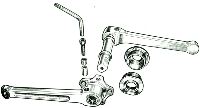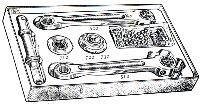

T.A.'s entry into the crankarm market came in the early/mid-60s with the intorduction of the revolutionary "criterium" cottered-but-cotterless crankset. Rather than a standard cottered bb spindle, the "criterium" spindle looks as if its half cottered spindle, and half cotterless square taper spindle.
At the time of its introduction, the cottered/cotterless design meant an end to hammering cotterpins, steel cranks and bb spindles rusting together and troublesome cotterpin extraction. during the overlap of the "criterium" and the introduction of the now-standard square taper spindle, it was also advertised as meaning no special extractor tools or loosening spindle bolts. Beyond all this, T.A.'s new cranks offered:
like the early T.A. headsets, the crankset came in a special "presentation" box definitely worthy of such an intriguing design and top-notch finish.
In the few short years that the "criterium" crankset was available, there were some slight variations in the crankset design. Crankarms were produced both with and without the T.A. stamping on the arm just below the spindle hole. You can also just barely make out two different widths of the fluting on the crankarms, but I'm not sure of any significance of this, and I don't know if anyone has figured out a correlation between time of production and either of these variances.
Above is a closeup of the spindle in the spindle hole, as it would appear assembled, and a closeup of the cap over the back of the pedal axle hole. I'm not sure what the advantage of the latter was supposed to be, but it is one of the most common things found damaged with these cranks (and other T.A. cranks with this feature). Pedals with longer axle threads than older Lyotards and similar pedals would punch out the backplate, as would some pedals if the pedal axle stop washer (ref:137) was forgotten.
The plastic dustcap is one of the rarer bits of this crankset, as it would eventually fall out of the hole in the bb spindle, as it was merely plastic, and press-fit. These purportedly came iin both white and grey versions, with the white possibly being the earlier versions.
Here is a closer shot of the "cotter" bolt - the two bevelled pieces acted like the filed bit of a standard cotterpin - pinching the spindle from either side, and fixing the crankarm tight on the "taper".
Thanks to an unwitting Satoru Masuda, from whose TA page I grabbed plenty of images.